Choosing heating devices and systems is not an easy task. What heating is best for a private home?
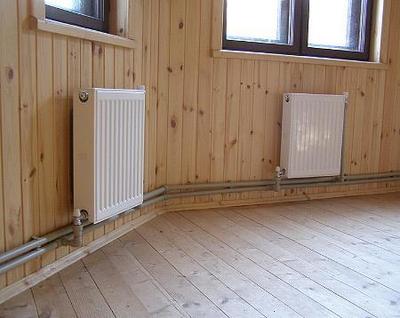
When planning the construction of their own home, the future owner chooses a heating system. A country house is heated in several ways. If you choose one of them correctly, the heating will be effective and inexpensive.
However, there are several factors to consider. These include: cost and availability of energy resources, as well as features installation and operation.
Permanence of residence is important: if the house is used only several months a year, there is no point in installing expensive heating equipment.
Content
Bake
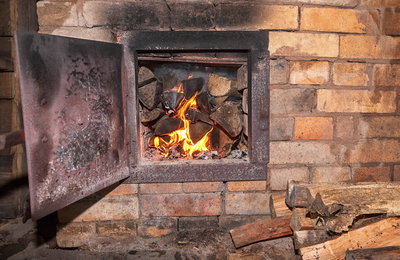
People heat their homes with the help of ovens for many centuries already.
During this time, many effective designs have been created that allow you not only to warm up, but also to prepare a wide variety of food or heat water for household needs.
A home heating stove is a device for burning solid fuel (firewood, coal, peat, pellets from wood waste). It is built from stone, brick or welded from metal.
Any stove has a combustion chamber, an ash pit, flue gas discharge channels and a chimney. Heating fuel is placed in the firebox on the grate. Air enters through the ash pit from below. Hot flue gases are removed through the channel into the chimney. The heating stove is supplemented with hob and oven for cooking and heating water.
Advantages and disadvantages
Advantages of stove heating:
- Low cost construction and operation.
- For stove heating no electricity, water or gas supply required. Firewood, coal and peat are inexpensive and are harvested almost everywhere.
- Because the oven does not have a liquid coolant, it does not need to be constantly heated. This option is suitable for a dacha that residents do not visit often.
- A variety of combined design options allow heat the room, cook food, dry herbs, clothes, mushrooms and berries, heat water.
- The homeowner can choose standard or individual projectMany companies and individual craftsmen are ready to build a custom-made stove.
Disadvantages of heating with stoves:

- The stove takes up quite a lot of space (2 sq. m or more). For uniform heating, it is usually placed in the center of the house.
- Quickly warm up the room with this heating impossible. Brick or stone masonry is heated several hours, but after heating it gives off heat for a long time.
- Heat transfer efficiency small. Increased by lengthening the channels.
- Unable to install automationAll maintenance of the heating system is done manually.
- The design of the furnace are planned when designing a house. Only qualified specialists do this.
- Firewood for the stove is prepared and dried in advanceA special room or shed is built for their storage.
Fireplace
Fireplaces are usually built in living room. This ancient heating device has become quite widespread in private homes, but it is used to heat only one room. Few homeowners realize that a fireplace is quite capable of heating an entire room.
Correct installation
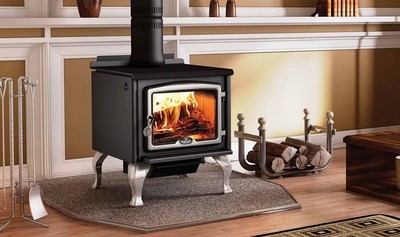
The design is a fireplace with an extended firebox and without a front wall. The flue gases exit directly into the chimney. This device does not have a heat carrier.
Heat is transferred into the room by radiation from the flame, as well as through the heated side walls and mantelpiece. After a little improvement, the fireplace is used to heat the entire house.
Heat transfer to other rooms is done in two ways:
- By a stream of heated air.
- With water through pipes.
In the first method, air passes through heated metal pipes in the fireplace and then flows through air ducts into the rooms on the second floor. In this way, heat is effectively transferred by gravity to the second floor and 3-4 m to the sides. This is enough to heat a small house. At a distance more than 4 m Air is supplied by a blower fan installed next to the fireplace.
In the second, the fireplace is combined with a conventional water heating system. In this case, the heat source is pipes mounted in the firebox. The pump pumps water through them and forces it into the radiators installed in the rooms.
Pros and cons
Advantages of fireplace heating:
- Does not require a coolantThe air itself plays this role.
- Heat generation does not depend from the feed electricity.
- Heating of rooms begins immediately after melting fireplace. Warming up the rooms takes only a few minutes.
- Operating costs small and depend mainly on the cost of firewood or coal.
Disadvantages of fireplace heating:
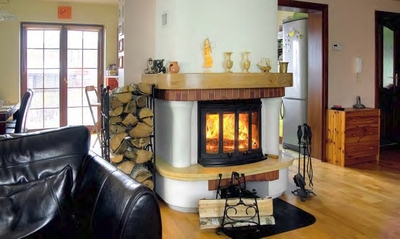
- Only two-story houses with an area of up to 150 m². If it is larger, it is required fan, which makes noise when operating and depends on the availability of electricity.
- When the fireplace goes out, the building quickly loses heat.
- The air flow carries into the rooms dust.
Water heating from a fireplace has the following positive aspects:
- Automatically adjusted using heating fittings.
- Heat transfer is also possible in rooms away from the fireplace.
Disadvantages of water heating:
- The water heating system requires qualified installation and is more expensive than air.
- Heating depends on power supply, because the coolant is pumped by an electric pump.
- If the premises are used as temporary housing, the pipes have to be filled antifreeze.
Water heating
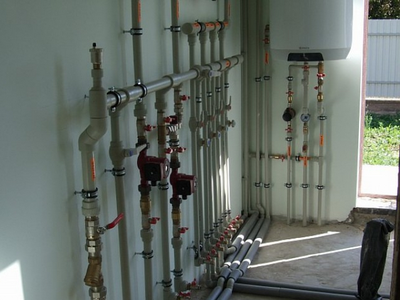
The heat source in this case is gas, solid fuel or electric boilers, and the heat is transferred by a liquid coolant.
Water or antifreeze is heated in the boiler heat exchanger and flows through pipes into the rooms, where it gives off heat radiators, heating the air in the room.
The supply of coolant in this heating system is carried out naturally: expansion during heating and rise into the storage tank or forcedly (by pump).
Is it worth choosing?
The positive aspects of water heating:
- System with gas or electric boiler automatically regulated. It is enough to set the required temperature on the thermostat, and it will be maintained.
- High efficiency. Modern gas and electric boilers are economical, using almost all of the fuel energy for heating.
Disadvantages of a water heating system:
- Water heating depends on the supply of gas and electricity. In case of shutdown, the boiler is blocked. It has to be restarted manually. Only a system with a solid fuel boiler and natural circulation works autonomously without electricity and gas.
- It is different complexity, therefore it requires calculations by specialists and proper installation. This is due to its high cost.
- During long outages, water freezes in the pipes, so it has to be replaced with expensive antifreeze.
Gas convectors
The heating device is characterized by high economy and convenienceGas convectors are installed under the window sill on the wall in each room.
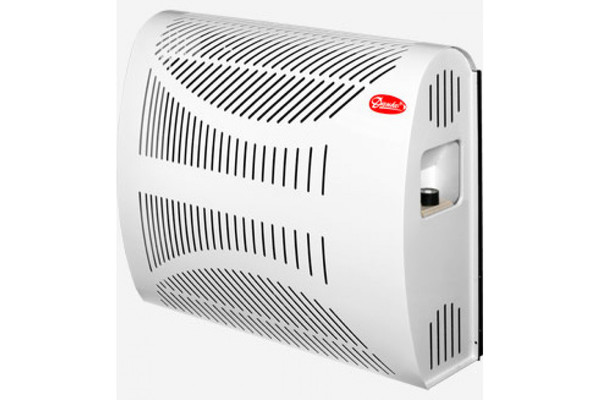
Photo 1. Gas convector model Briz 4S, power 4 kW, manufacturer "Danko", Ukraine.
The gas entering the convector through the pipes burns in it, and the combustion products are removed through the flue pipe in the wall. The heat is transferred to heat exchanger directly to the air without additional heat carrier. Modern gas convectors are equipped with a control system that regulates gas combustion depending on the air temperature in the room. Natural or liquefied gas is used for heating.
There are two types of gas convectors:
- ventilators;
- without fan.
Attention! Fans are used for heating. non-residential rooms, because the fan creates noise. But they are distinguished by a more uniform distribution of warm air.
Advantages and disadvantages
The positive aspects of heating with gas convectors:
- Gas convectors consume only outside air, They do not smoke or create unpleasant odors in the room.
- Fuel no need to prepare in advance, no storage space is required. When using liquefied gas, the cylinder is placed outside or in a separate room.
- Automatic regulation.

- EconomyAlmost all combustion energy is transferred directly to the air.
- VersatilityThe device is easily adjusted to liquefied or natural gas.
Disadvantages of gas convectors:
- Addiction from gas and electricity suppliesWhen they are switched off, the convector is blocked.
- Necessary qualified gas distribution into premises in compliance with fire safety regulations.
Electric convectors
These heating devices most accessible. No special placement conditions are required. It is enough to install the electric convector yourself and connect it to the power grid. There are three types of such devices:
- floor (they are installed on wheels, which allow them to be moved to a convenient location).
- wall-mounted;
- installed under the floor.
The source of heat of the electric convector is tubular electric heater (TEN). This is a metal tube with a nichrome wire inside, insulated from the walls by quartz filling or ceramics. Electric current heats the heating element, and the heating element gives off heat to the air. Modern devices are also equipped with thermostat, air filter and air ionizer. The floor version contains a sensor that switches off the heating device if it falls.
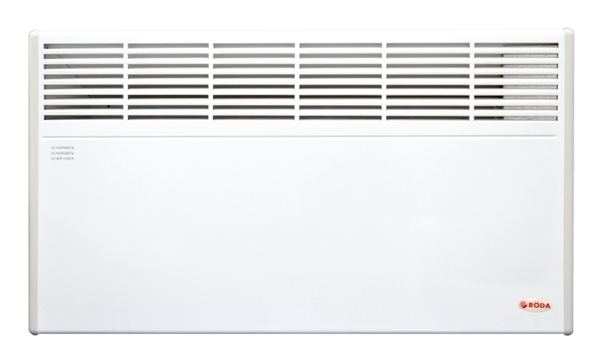
Photo 2. Electric convector model Standart, power - 2.5 kW, manufacturer "Roda", Germany.
Advantages and disadvantages
Advantages of electric convectors:
- Easy to install and the absence of specific requirements.
- CompactnessFloor convectors are invisible after installation.
- Uniform heating air, especially in combination with underfloor heating.
- The operation of these devices is regulated by a thermostat. automatically.
- High efficiency, quick heating of the room.
Disadvantages of electric convectors:
- Dependence on electricity.
- High cost heating.
Heat pump
This term refers to a heating system based on transfer of heat from the external environment to the room. Such units are not often installed in private homes yet, but their prevalence is increasing.
Any heat pump is designed in the same way as a refrigeration unit. The difference between these devices is where the heat is taken from and where it is transferred. A refrigerator absorbs heat in a closed space and releases it outside, while a heat pump transfers thermal energy into the room.
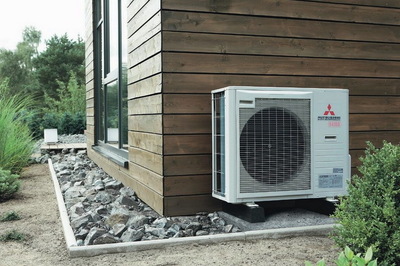
A well-known example of a heat pump is air conditioner with heatingIn summer, its indoor unit operates in evaporator mode, and the outdoor unit serves as a condenser.
In winter, the heat pump mode is switched, as a result of which the outdoor unit becomes the evaporator, and the indoor unit turns into a condenser. Thus, the heating air conditioner is a universal heat pump.
There are also heat pumps that work for heating only. The evaporator of such a unit is placed in the ground or in the nearest body of water, and the condensers are placed in the rooms of the house. The heating system is filled refrigerant, which is pumped by a compressor. The operation of the heat pump is controlled by an electronic unit that maintains a constant temperature in the rooms.
Advantages and disadvantages
Advantages of a heat pump:
- High efficiency. The unit does not generate heat, but only transfers it. Thus, with the power of the pump's electric motor 1 kW, the thermal power of the unit reaches 4-5 kW.
- No need for fuel.
- Ecological purity.
- Switching capability for cooling in the summer.
Disadvantages of a heat pump:
- Dependence on electricity supplies.
- To install the evaporator you need a large area of land or water body.
- Custom design requires the services of specialists.
- High cost.
Useful video
Check out the video that talks about the different heating options for a private home.
Conclusions: what type of heating is best for heating a private house
The variety of heating designs allows you to choose for your home the most efficient and least expensiveIf the homeowner has difficulty making a choice, specialists will help design and install a suitable heating system.






